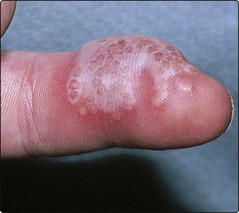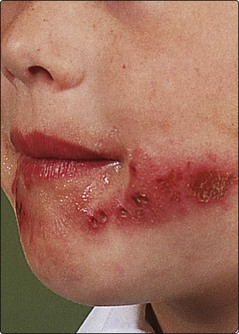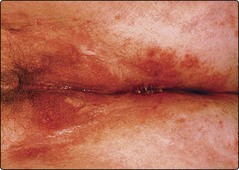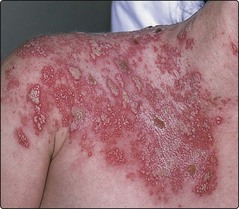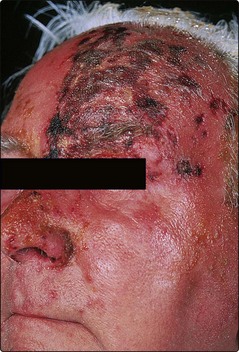Viral infections – Herpes simplex and herpes zoster
Herpes simplex
Clinical presentation
Herpetic whitlow is another presentation (Fig. 1). A painful vesicle or pustule is found on a finger in, for example, a nurse or dentist attending a patient secreting the virus. Similar direct inoculation is sometimes seen in sportsmen such as wrestlers (‘herpes gladiatorum’).
Recurrence is a hallmark of herpes simplex infection; it occurs at a similar site each time, usually on the lips, face (Fig. 2) or genitals (Fig. 3). Rarely, herpes simplex may appear in a zosteriform dermatomal distribution. The outbreak of groups of vesicles is often preceded for a few hours by tingling or burning. Crusts form within 24–48 h, and the infection fades after a week. Attacks may be precipitated by respiratory infection (hence ‘cold’ sore), sunlight or local trauma.
Complications
Complications are infrequent but can be serious. They include the following:
 Secondary bacterial infection. This is usually due to Staphylococcus aureus.
Secondary bacterial infection. This is usually due to Staphylococcus aureus.
 Eczema herpeticum. Widespread herpes simplex infection is a serious and potentially fatal complication seen in patients with atopic eczema (p. 36) or Darier’s disease (p. 90).
Eczema herpeticum. Widespread herpes simplex infection is a serious and potentially fatal complication seen in patients with atopic eczema (p. 36) or Darier’s disease (p. 90).
 Disseminated herpes simplex. Widespread herpetic vesicles may occur in the newborn or in immunosuppressed patients.
Disseminated herpes simplex. Widespread herpetic vesicles may occur in the newborn or in immunosuppressed patients.
 Chronic herpes simplex. Atypical and chronic lesions may be seen in patients with HIV infection.
Chronic herpes simplex. Atypical and chronic lesions may be seen in patients with HIV infection.
 Herpes encephalitis. This is a serious complication of herpes simplex, not always accompanied by skin lesions.
Herpes encephalitis. This is a serious complication of herpes simplex, not always accompanied by skin lesions.
 Carcinoma of the cervix. This is more common in women with serological evidence of infection with type 2 herpes simplex, which may be a predisposing factor.
Carcinoma of the cervix. This is more common in women with serological evidence of infection with type 2 herpes simplex, which may be a predisposing factor.
 Erythema multiforme. Herpes simplex infection is the most common cause of recurrent erythema multiforme (p. 82).
Erythema multiforme. Herpes simplex infection is the most common cause of recurrent erythema multiforme (p. 82).
Management
Mild herpetic lesions may not require any medication. The treatment of choice for recurrent mild facial or genital herpes simplex is aciclovir (Zovirax) cream (applied five times a day for 5 days), which reduces the length of the attack and the duration of viral shedding, and should preferably be started at the first indication of a recrudescence. More severe episodes warrant oral treatment with aciclovir (200 mg five times a day for 5 days), which shortens the attack. Long-term oral administration is useful in those with frequent recurrent attacks. Intravenous aciclovir may be life-saving in the immunosuppressed and in infants with eczema herpeticum. Genital herpes simplex can also be treated with oral famciclovir or valaciclovir. In those with genital herpes simplex, barrier contraception methods are advisable during intercourse, and intercourse should be avoided during symptomatic episodes.
Herpes zoster
Clinical presentation
Pain, tenderness or paraesthesia in the dermatome may precede the eruption by 3–5 days. Erythema and grouped vesicles follow, scattered within the dermatomal area (Fig. 4). The vesicles become pustular and then form crusts that separate in 2–3 weeks to leave scarring. Secondary bacterial infection may occur. Herpes zoster is normally unilateral and may involve adjacent dermatomes. The thoracic dermatomes are affected in 50% of cases and, in the elderly, involvement of the ophthalmic division of the trigeminal nerve is particularly common (Fig. 5). Two-thirds of patients with herpes zoster are over 50 years of age, and it is uncommon in children. The lesions shed virus, and contacts with no previous exposure may develop chickenpox.
Complications
Serious complications may occur in herpes zoster. These include the following:
 Ophthalmic disease. Corneal ulcers and scarring may result from shingles of the first trigeminal division. Ophthalmological assistance is mandatory.
Ophthalmic disease. Corneal ulcers and scarring may result from shingles of the first trigeminal division. Ophthalmological assistance is mandatory.
 Motor palsy. Rarely, the viral involvement may spread from the posterior horn of the spinal cord to the anterior horn, and result in a motor disorder. Cranial nerve palsies or paralysis of the diaphragm or other muscle groups may occur.
Motor palsy. Rarely, the viral involvement may spread from the posterior horn of the spinal cord to the anterior horn, and result in a motor disorder. Cranial nerve palsies or paralysis of the diaphragm or other muscle groups may occur.
 Disseminated herpes zoster. Immunosuppressed subjects, and patients with Hodgkin’s disease in particular, can develop confluent haemorrhagic involvement, which spreads and may become necrotic or gangrenous. Varicella pneumonia or encephalitis are potentially fatal.
Disseminated herpes zoster. Immunosuppressed subjects, and patients with Hodgkin’s disease in particular, can develop confluent haemorrhagic involvement, which spreads and may become necrotic or gangrenous. Varicella pneumonia or encephalitis are potentially fatal.
 Post-herpetic neuralgia. Neuralgia is infrequent in patients under 40 years but is found in a third of those over 60 years. The pain subsides in the majority within 12 months.
Post-herpetic neuralgia. Neuralgia is infrequent in patients under 40 years but is found in a third of those over 60 years. The pain subsides in the majority within 12 months.

